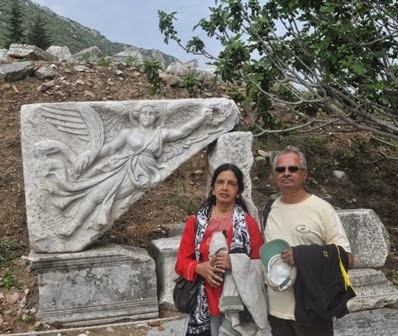On to Pamukkale
from Konya
We reached
Pamukkale in the afternoon of 8th May. Pamukkale is one of Turkey’s major attractions with
the hot spring travertine terraces and the Hierapolis.
PAMUKKALE
TRAVERTINES
Pamukkale means
"cotton castle" in Turkish, is a natural geological site. Due
to under ground volcanic activity, hot
springs are formed. The water flows on the surface and calcium carbonate
minerals left by the flowing water forms the white Travertine terraces giving
the place its name. The thermal springs were first noticed in the 2nd
century and ruins of that period can be seen on the site.
The springs form part of a
complex hydraulic system extending 70 km to the north-west to Alasehir and
west along the valley of the Menderes River. These canals take thermal water to
nearby villages and agricultural areas, some over the years having accumulated
travertine deposits up to 10 m in height.
The terraces look amazing. There
are cascades and terraced pools. The water is said to have therauptic value and
tourists walk in them. Pools with this water have also been created for those
interested in swimming. One of such pools is called Cleopatra pool and they
charge 45 TL to use it. Even hotels have thermal pools filled with this water.
HIERAPOLIS
Hierapolis was developed
adjacent to the hot water springs.
The Christian
monuments of Hierapolis constitute an outstanding example of an early Christian
architectural complex.
The Temple of
Apollo was erected on a fault from which abnoxious vapours escaped. The theatre
is decorated with an admirable frieze depicting a ritual procession and a
sacrifice to the Ephesian Artemis. The necropolis affords a vast panorama of
the funerary practices of the Graeco-Roman epoch. According to ancient
tradition, Philip the Apostle converted it and was crucified there by Domitian
around the year 87.. The group of Christian buildings are the cathedral,
baptistry and churches. The most important monument is the martyrium of St Philip.
In April 2013 Archaeologists said they have discovered in Turkey the
ruins of a temple referred to in antiquity as the "Gate to Hell."



























No comments:
Post a Comment